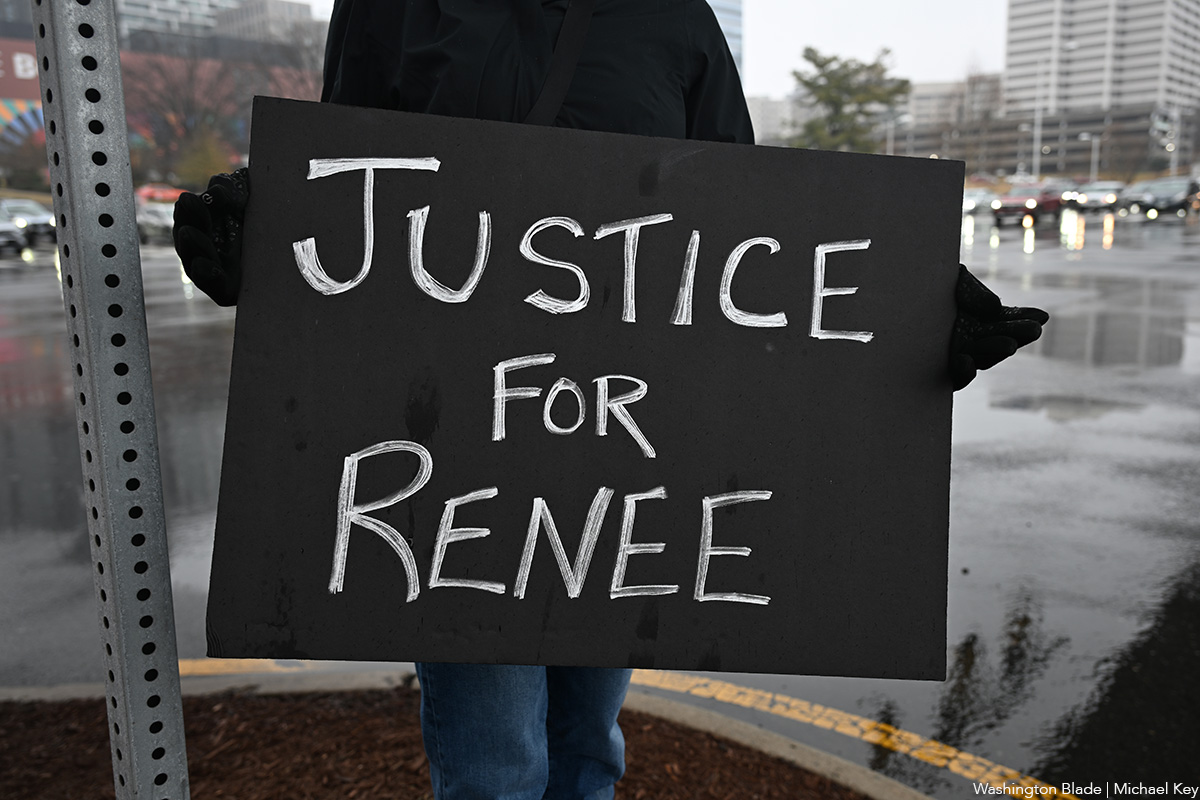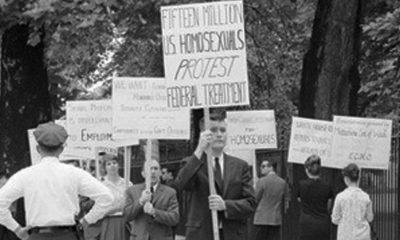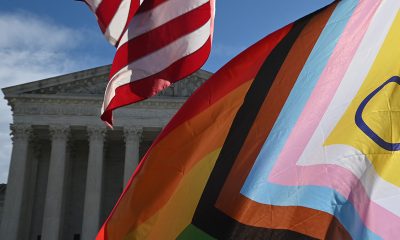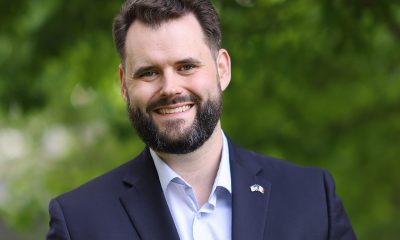Opinions
Kameny’s storybook ending
Vindication after decades of struggle

Frank Kameny (center) at the Library of Congress’ ‘Creating the United States’ exhibit looking at his 1961 Supreme Court brief flanked by historian John Haynes (left) and Charles Francis. (Photo by Charles Francis)
The freight elevator opened with a shudder. It sounded like a death rattle. Gloved attendants pushed the sheet-covered gurney down a long corridor, stopping at the doors to a vault. The doors opened onto a room of drawers and lockers surrounding a platform —like a morgue.
We gathered and held our breath as the attendants rolled back the shroud. Where one might expect a pair of legs were wooden sticks. Nicked and numbered, the sticks were not attached to a corpse but a neat pile of well-aged picket signs, hand-lettered, “First Class Citizenship for Homosexuals.” Frank Kameny stood silent, at near attention. And this man was rarely silent. The pickets, carried in 1965, were delivered at that moment in 2006 from his attic to the nation’s — the vault of the National Museum of American History of the Smithsonian Institution.
The pickets were placed on the platform. The Smithsonian curator laid them alongside the writing table where Jefferson wrote the Declaration of Independence; the inkwell used by Lincoln when signing the Emancipation Proclamation; and the pin worn by Alice Paul who went to jail picketing the White House for women’s suffrage. “Frank, this is where the pickets fit into American history,” the Smithsonian curator said.
Last week, Washington, D.C.’s gay community lost a warrior-general and a good friend, Franklin E. Kameny. Even more, America lost a man who helped create the United States. Yes, create the United States. For the past six months, Kameny’s 1961 petition to the Supreme Court has been on display at the Library of Congress in its exhibition: “Creating the United States,” chronicling how citizens have steadily expanded American liberty under the Declaration of Independence, the Bill of Rights and the Constitution. Like the Smithsonian, the Library of Congress placed Kameny’s papers among the great stories of abolition, women’s suffrage and civil rights. He was the first to consistently anchor the gay and lesbian fight for civil equality — not in angst, alienation or radical ideology, but in the words of Thomas Jefferson and the Constitution, itself.
Kameny’s petition to overturn his firing by the federal government in 1957 for being homosexual, was denied, but it began a revolution in culture and law. After Kameny, no longer would gay and lesbian Americans, in isolation, supinely accept second-class status. “We are throwing down the gauntlet!” he declared.
Kameny’s petition to the Supreme Court became a faintly remembered footnote until rediscovered and re-interpreted for our time. Kameny wrote: “In World War II, petitioner did not hesitate to fight the Germans, with bullets, in order to help preserve his rights and freedoms and liberties, and those of others. In 1960, it is ironically necessary that he fight the Americans, with words, in order to preserve, against a tyrannical government, some of those same rights, freedoms and liberties, for himself and others.”
Today, Paul Smith, the Supreme Court attorney in Washington, D.C., who represented Lawrence, in the case Lawrence v. Texas, 2003 (and won) wrote, “It is astounding to see Kameny, in 1960, making the same arguments that have now caused the invalidation of sodomy laws, the protection of LGBT civil servants from discrimination, and the repeal of Don’t Ask, Don’t Tell.”
Kameny yells up the attic ladder: “Hey, I’m coming up now. I’m coming up!” Well into his 80s, he climbed into the attic to join me in a dusty netherworld of political papers. Boxes by the score overflow with single-spaced, multi-page typewritten letters and carbons, newsletters, transcripts, umpteen boxes of Washington Blades, every gay publication from “Drum” to “One” and two black typewriters that looked like anvils. “News Release: Homosexuals to Picket White House,” “Homosexuals to Picket Pentagon,” “Homosexuals to Picket State Department.” In a far corner, lay the pickets, one proclaiming “Homosexuals Ask for the Right to the Pursuit of Happiness.” The man saved everything. He never moved. He never discarded. He never denied gay history. Today, some 70,000 items gleaned from this attic are organized for appreciation and research at The Library of Congress. Go there.
Kameny hated how LGBT history was so often deleted. Tom Brokaw felt the force of Kameny’s ire with the publication of his pop-history, “Boom! Voices of the Sixties” (Random House, 2007). Brokaw somehow neglected to mention the Stonewall riots or any reference whatever to gay and lesbian Americans and the impact they, too, had on the decade. Kameny wrote, “Mr. Brokaw, you have de-gayed the entire decade!”
Speaking for his comrades, Kameny wrote, “Mr. Brokaw, [in your book] you deal with the histories of countless individuals. Where are the gays of that era: Barbara Gittings; Jack Nichols; Harry Hay; Del Martin and Phyllis Lyon; Randolfe Wicker; Harvey Milk; and numerous others?” Kameny continued, “Mr. Brokaw, the whole thing is deeply insulting. You have de-gayed an entire generation. … Gay is Good. You are not. Sincerely, Frank Kameny.”
Unpack Frank’s trademark blast, and you can hear the voice of a leader fiercely committed to those who came before him like Harry Hay, colleagues and friends like Nichols, Martin, Wicker and Gittings; an LGBT community that had suffered so; and his place in history, too.
Everywhere Frank appeared in the last months of his life, he happily reminded people — whether at the Library or his last HRC dinner or as an honoree at the D.C. Center for the LGBT Community — his life did have “a storybook ending.”
“They mulled over my appeal for 52 years! Office of Personnel Management Director John Berry issued a formal apology on behalf of the government. Things have come full circle.”
“Oh, if only John Macy (Berry’s predecessor and Frank’s arch foe so many years ago) were alive to see this,” he cackled.
Charles Francis is founder of the Kameny Papers Project.
Opinions
Media obsess over ‘Heated Rivalry’ sex but ignore problem of homophobia in sports
4 major men’s leagues lack gay representation 13 years after Jason Collins came out

The mainstream media are agog over “Heated Rivalry,” the surprise hit HBO Max limited series about two professional hockey players who fall in love.
The show’s stars, Connor Storrie (Ilya) and Hudson Williams (Shane), are everywhere — red carpets, award shows, morning news and late night shows. Female fans lined up for hours to catch a glimpse of Storrie, who appeared on the “Today” show last week.
The interviews and coverage predictably involve lots of innuendo and snickering about the graphic sex scenes in the show. Storrie and Williams have played coy about their real-life sexual orientation, a subject of debate among some gay fans who would prefer they own their sexuality if, in fact, they are gay.
But the big issue ignored by the media that the show tackles is the crippling effect of homophobia and the closet — not just on professional athletes but on anyone who isn’t comfortable being out at work. And it’s a growing problem given the hostile Trump administration. Attacks on LGBTQ people and the roll back of DEI and related protections are driving many Americans back into the closet, especially in D.C.’s large federal workforce.
And the mainstream media seem totally unaware that there has never been an openly gay NHL player. Hell, there’s never even been a retired NHL player who came out.
It’s a sad fact that I would not have predicted 13 years ago when Jason Collins bravely came out publicly while playing in the NBA, the first male athlete in the big four U.S. sports to do so. His announcement was widely covered in the mainstream media and Collins was even named to Time magazine’s “100 Most Influential People” list in 2014.
Then in February 2014, Michael Sam became the first openly gay player to be drafted into the NFL. He was released before the season began and did not play. But still, Sam’s decision to come out was celebrated. It felt like professional male sports was changing and finally shaking off its ingrained homophobia. Many of us awaited a flood of young professional athletes coming out publicly. And we waited. And waited. Then, seven years later, in June 2021, Carl Nassib came out, becoming the first active NFL player to do so. He was with the Las Vegas Raiders at the time and also became the first out player to play in the playoffs. He was released in the offseason and picked up by the Tampa Bay Buccaneers in 2022 and retired the following year.
And that is the short history of out professional male athletes in the big four U.S. sports. (Women’s sports is a different story with many examples of out lesbian and bi players.)
Sure, some pro athletes have come out after retiring, most notably Billy Bean, who went on to a long and successful career advocating from within for gay representation in Major League Baseball as the league’s vice president and ambassador for inclusion and later as senior vice president and special assistant to the commissioner.
But that’s a sorry record and professional sports leagues should redouble their efforts at making gay players (and fans) feel welcome. From fully embracing Pride nights again to adopting zero tolerance policies for hate speech, there’s much more work to be done to make it easier for pro male athletes to come out.
“Heated Rivalry” star Williams recently told an interviewer that he has received private messages from closeted active pro athletes in multiple sports who don’t feel they can come out. How sad that in 2026, even the most successful (and wealthy) among us still feel compelled to hide in the closet.
Let’s hope that “Heated Rivalry,” which has been renewed for a second season, sparks a more enlightened conversation about the closet and the need to foster affirming workplaces in professional sports and beyond.
Kevin Naff is editor of the Washington Blade. Reach him at [email protected].
Opinions
Do not forget that Renee Good was queer
Far-right media link shooting victim’s sexuality to her protest of ICE

Please do not forget that Renee Nicole Good was a queer woman.
Last week, Good, a 37-year-old American citizen, was shot and killed by a United States Immigration and Customs Enforcement agent in Minneapolis. Her wife Rebecca Good was present when the ICE agent shot her, standing outside their car. In the immediate aftermath, Minneapolis erupted with protests aimed at ICE in the city and Republican officials, including President Donald Trump and Vice President JD Vance, who argued the shooting was justified as an act of self-defense.
In a press conference held this past Thursday, Vance told reporters that Good was “a victim of left-wing ideology.” “I can believe that her death is a tragedy,” Vance said,” while also recognizing that it is a tragedy of her own making.” Many criticized Vance’s statement, especially given how he blamed “left-wing extremism” for Charlie Kirk’s death in September on a Utah campus and Vance himself doubled down on condemning those who were celebrating the far-right podcaster’s fatal shooting.
Department of Homeland Security Secretary Kristi Noem implied that Good was a domestic terrorist while Fox News host Jesse Watters said that “the woman who lost her life was a self-proclaimed poet from Colorado with pronouns in her bio.”
Laura Loomer, another far-right Trump supporter, tweeted, “‘She/her.’ Literally every time,” in response to what is believed to be Good’s Instagram account. Loomer and Watters both pointed out her pronouns are somehow part of the reason she was tied to ICE-related violence.
As these comments from far right pundits show, far-right media coverage was quick to connect Good’s queerness to her work to inhibit ICE activity in Minneapolis.
But while far-right news outlets highlighting Good’s queerness, centrist and even leftist news outlets also erased her wife’s experience, featuring interviews with Good’s mom and ex-husband but not her wife who was present for the shooting, feeding into the narrative that she was an “innocent” white mother while denying Good’s own agency in mobilizing for immigrants in her community.
Nobody should be shot by government agencies ever, and these news outlets do not need to play into the construction of an “innocent” white woman for people to be outraged by her death. In fact, in doing so and denying Good’s queerness, they deny the way in which Good’s identity likely affected the way she interacted with the police. For queer and trans people, police are not safe people–in fact, Good’s last words deescalating the situation reflect the ways that homophobia and misogyny prime queer women, and all women to placate men’s emotions.
And it still didn’t work. After shooting her, the ICE agent called her a “fucking bitch,” in front of her wife who was kept away from Good while she bled out in her car.
When the media reinforces the narrative that she was an “innocent” mother, it reinforces the same sexism and racism that allows police brutality to continue.
In an interview, author of the book After Purity released this past December, Sara Moslener said that “White womanhood has been constructed to require that white women sort of maintain purity within themselves as a way to maintain the purity within themselves as a way to maintain the purity of, the innocence of, the nation state. When the purity movement resurfaced in the 1990s, it was this recapitulation of the 19th century nation of sexual purity that was highly racialized.”
“It wasn’t something that was accessible to enslaved women, to other women of color, to immigrant women. It was this ideal of true womanhood that became connected to this idea of a strong nationstate. That rhetoric was then used to justify racial terror lynchings. If white women were threatened, you know, physically, bodily, culturally, they have the right to claim things. This was often used as a guise to justify violence and murder, especially against Black men. It even ties to the concept of Karen and the entitlement of white women, where they can weaponize their vulnerability,” Moslener said.
Good’s shooting for many people was a breaking point for this very reason — because it represented the first time that they had witnessed a white person killed by an ICE agent or a member of the police.
For some, their whiteness had been a source of safety because of the privilege of their skin color, or so they thought until Good’s murder this past week. In the aftermath, they are rethinking if this privilege will continue to protect them and what it can mean in a world where violence against white women’s bodies has long caused social backlash.
This is not a reason to stop fighting — Good was not the first person killed by ICE, not even the first person killed by ICE in 2026, but her whiteness is one of the central reasons that it incited outrage — because of a society that privileges and protects white women’s bodies. To describe Good as solely an “innocent” white woman, to deny her queerness, is to play into this performance of outrage about the brutalization of white women’s bodies.
If discussions of Good’s queerness — and persistent queerphobia against queer women — is not considered in our outrage, in our protests, we feed right into the same narratives that mean some police brutality, especially that against queer and trans people and people of color, goes completely unreported and unchallenged.
This is state-sanctioned violence, and in the immediate aftermath of Good’s death, the Trump administration has demanded that people deny the evidence of their eyes and ears, has pushed the narrative that Good weaponized her vehicle against an ICE agent and that agent fatally shooting her was an act of self defense. This is categorically false but denying what we know to be true, what we can witness ourselves and understand, is the final step in fascism armed and funded by the government.
But let’s be frank: This is not the first time that the American police or a government agent has murdered an unarmed person. Just under six years ago, George Floyd was murdered by police officers in the same city — his death was a breaking point for many who had witnessed police brutality against people of color.
While people are eager to say Good’s name, we cannot say or remember her without remembering and saying the names of Black and Brown men and women, especially disabled people of color, who have been murdered in the hundreds by the police. Their names are often said, their murders often go unquestioned.
People have been and will continue to say Good’s name largely because she was a white woman but the names of Black and Brown people go unsaid and unrecognized because of a system that performs outrage about violence against white bodies. What Good’s murder realized was how a system built on the protection of white women — a Christian nationalism committed to Social Purity — will still sacrifice white women who refuse to fall in line.
Six federal prosecutors in Minnesota resigned this week over the Justice Department’s push to investigate Good’s widow. Among them was Joseph Thompson, a career federal prosecutor, who objected to investigating Good’s wife as well as the department’s refusal to investigate whether the shooting was lawful.
In the signs, in the protests, in the prayers and pleas that you say and make in the aftermath of Good’s murder, do not deny her queerness, do not deny who she was and do not deny the work she did because in performing outrage against the murder of an “innocent” white mother we replicate the same systems of harm that hurt us all.
Emma Cieslik is a museum worker and public historian.
Letter-to-the-Editor
D.C. electoral bumper car season is in full swing
More than a dozen candidates running for incumbent Eleanor Holmes Norton’s seat

The District of Columbia has entered into a challenging time not seen since Dr. Martin Luther King was murdered, the city burned and rioted and risked home rule being taken away. While statehood has twice passed the U.S. House of Representatives, the dream of being the 51st star on the American flag stagnates, to say the least.
Currently according to Politics 1.com, there are already 14 Democrats including two sitting members of the City Council (At-Large Robert White and Ward 2’s Brooke Pinto) and one Republican who have declared their candidacy to become the new voice in Congress. Unfortunately Congresswoman Eleanor Holmes Norton has refused to either announce her intentions to run for re-election again or gracefully acknowledge her time is over and she is ready to hand over the reins to continue the battles inflicted upon our home city. Congressional representation by press releases has simply got to stop as soon as possible!
Rank choice voting is going to be implemented in this 2026 cycle despite efforts to overturn or delay its implementation. Regardless of your thoughts on the new system, this will be one very interesting contest year to say the least. Rank choice … ready or not … here it comes!
Needless to say, the race for the Congressional seat is not the only major contest. Let us not forget the other positions up for election: the mayor, the attorney general, the chairman of the City Council, several ward and at-large races for the council. Add all these up and you will be looking at more moves on the political chess board than seen in the first Harry Potter film with the same results too. (As an aside, while the District of Columbia has no elected senators, it should be pointed out that any elected House member AND the District mayor have Senate floor privileges when in session.)
Before the June primary, it would be wise to make sure your voting registration is still current at the D.C. Board of Elections. Also, please urge friends not registered to do so as soon as possible. May we have the strength and will power to take back our city and stand up to those who want to destroy it.




















